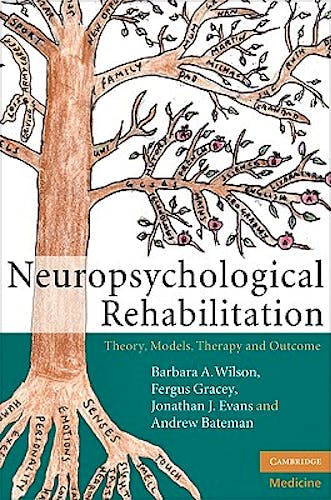

No hay productos en el carrito



Neuropsychological Rehabilitation. Theory, Models, Therapy and Outcome
Wilson, B. — Gracey, F. — Evans, J. — Bateman, A.
1ª Edición Julio 2009
Inglés
Tapa dura
380 pags
760 gr
17 x 24 x 2 cm
ISBN 9780521841498
Editorial CAMBRIDGE
LIBRO IMPRESO
-5%
142,50 €135,38 €IVA incluido
137,02 €130,17 €IVA no incluido
Recíbelo en un plazo de
2 - 3 semanas
LIBRO ELECTRÓNICO
-5%
128,66 €122,23 €IVA incluido
123,71 €117,53 €IVA no incluido
Acceso On Line
Inmediato
The aim of neuropsychological rehabilitation is to enable people with cognitive, emotional, or behavioural deficits to achieve their maximum potential in the domains of psychological, social, leisure, vocational or everyday functioning. Describing the holistic programme devised and adopted at the world famous Oliver Zangwill Centre and embracing a broad theoretical base, incorporating a variety of frameworks, theories and models, this book proposes an integrated approach to brain injury rehabilitation by an interdisciplinary team. The coverage explains the underlying principles involved, describes the group therapies employed, highlights a selection of real case examples and reviews the outcomes measured and achieved. This book is essential reading for clinical neuropsychologists, clinical psychologists, speech and language therapists, occupational therapists, psychiatrists, neurologists, physiotherapists, social workers and nurses.
• Describes in detail the holistic rehabilitation programme, devised and adopted at the world famous Oliver Zangwill Centre • Details the therapeutic strategies employed enabling the reader to establish similar group approaches • Includes real case examples illustrating different aspects of holistic rehabilitation
Contents
Contents; Preface; Foreword Keith Cicerone; Part I. Background and Theory: 1. Towards a comprehensive model of neuropsychological rehabilitation Barbara A. Wilson and Fergus Gracey; 2. Evidence for the effectiveness of neuropsychological rehabilitation Barbara A. Wilson; 3. Goal setting as a way of planning and evaluating neuropsychological rehabilitation Barbara A. Wilson, Jonathan J. Evans and Fergus Gracey; 4. The Oliver Zangwill Centre approach to neuropsychological rehabilitation Barbara A. Wilson, Fergus Gracey, Donna Malley, Andrew Bateman and Jonathan J. Evans; Part II. Group Interventions: 5. The Understanding Brain Injury (UBI) Group Barbara A. Wilson, Andrew Bateman and Jonathan J. Evans; 6. The Cognitive Group, part 1: attention and goal management Jonathan J. Evans; 7. The Cognitive Group, part 2: memory Jonathan J. Evans; 8. The Mood Management Group Kate Psaila and Fergus Gracey; 9. The Psychological Support Group Fergus Gracey, Giles Yeates, Siobhan Palmer and Kate Psaila; 10. Working with families in neuropsychological rehabilitation Giles Yeates; 11. Communication Group Clare Keohane; 12. Practically-based project groups Donna Malley, Andrew Bateman and Fergus Gracey; Part III. Case Illustrations: 13. Peter: successful rehabilitation following a severe head injury with cerebro-vascular complications Barbara A. Wilson; 14. Lorna: applying models of language, calculation, and learning within holistic rehabilitation – from dysphasia and dyscalculia to independent cooking and travel Leyla Prince, Clare Keohane, Fergus Gracey, Joanna Cope, Sarah Connell, Carolyne Threadgold, Jacqui Cooper, Kate Psaila, Donna Malley and Barbara A. Wilson; 15. Caroline: treating PTSD after traumatic brain injury Jonathan J. Evans and W. Huw Williams; 16. Interdisciplinary vocational rehabilitation addressing pain, fatigue, anxiety and impulsivity: Yusuf and his 'new rules for business and life' Fergus Gracey, Donna Malley and Jonathan J. Evans; 17. Judith: learning to do things 'at the drop of a hat': behavioural experiments to explore and change the 'meaning' in meaningful functional activity Fergus Gracey, Susan Brentnall and Rachel Megoran; 18. Simon: brain injury and the family - the inclusion of children, family members and wider systems in the rehabilitation process Siobhan Palmer, Kate Psaila and Giles Yeates; 19. Adam: extending the therapeutic milieu into the community in the rehabilitation of a client with severe aphasia and apraxia Jacqui Cooper and Andrew Bateman; 20. Malcolm: coping with the effects of Balint's syndrome and topographical disorientation Barbara A. Wilson; 21. Kate: cognitive recovery and emotional adjustment in a young woman who was unresponsive for several months Barbara A. Wilson; Part IV. Outcomes: 22. Is this approach effective? Outcome measurement at the Oliver Zangwill Centre Andrew Bateman; Index.
© 2025 Axón Librería S.L.
2.149.0